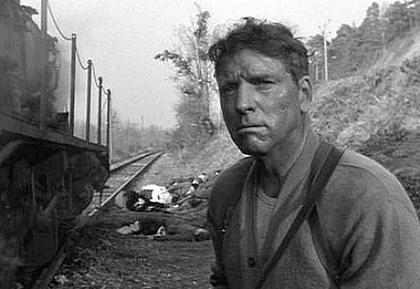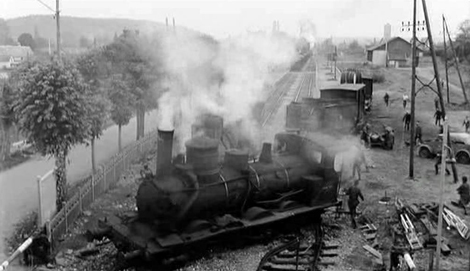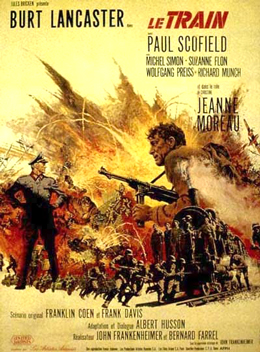|
|
Reviewed by Glenn Erickson
Having conquered the world of live television and made his mark as a director of cerebral political thrillers, for his next two films John Frankenheimer turned his talents to daunting technical challenges. For Grand Prix he found new ways to mount 70mm cameras on Formula 1 racing cars, and made a lot of viewers lean into turns and grip the armrests on their seats. But 1964's The Train, an intense WW2 story about the French resistance, is among the most physically complex, most realistic major action films ever made. Frankenheimer inherited the job after the powerful star Burt Lancaster jettisoned his first director, Arthur Penn. A heady mix of kinetic excitement and moral questions about the relative value of art and human lives, The Train wowed audiences of all kinds. Veterans approved of its realism and avoidance of Hollywood clichés. Women had two magnetic male stars to admire, Lancaster and Englishman Paul Scofield. And fans of action films were duly impressed by the film's attention to detail. Although trains are shot up, bombed, sabotaged and crashed together in hair-raising action scenes, few optical special effects and no models were employed. We're told that one misjudged train impact wiped out all but one of the unmanned cameras positioned to film it. It's one of the miracle shots of the movies -- hundreds of tons of iron and metal come smashing at us, and stop with a spinning train wheel suspended in the air, just inches from the lens.
I surely hope that Buster Keaton had a chance to see and enjoy The Train... he's perhaps the only filmmaker before this who had as much freedom to 'play toy trains' with the real thing. 1

In August of 1944 Paris is only days from being liberated and the occupying Germans are evacuating as fast as they can. German Staff Officer Von Waldheim (Paul Scofield of Carve Her Name with Pride) has been collecting and 'safeguarding' a horde of art treasures at a museum, and now puts together a special train to spirit them all to Germany. Museum directress Mlle Villard (Suzanne Flon of Mr. Arkadin) begs the French yard dispatcher (and train engineer) Labiche (Burt Lancaster) to save France's national treasure, so the highly organized resistance underground in the railway system goes to work. The sabotage starts small and eventually accelerates until Labiche and his close comrades Jacques, Pesquet and Didont (Jacques Marin, Charles Millot & Albert Rémy) are putting their lives in jeopardy, as well as anyone who helps them, like innkeeper Christine (Jeanne Moreau). Elderly engineer Papa Boule (Michel Simon) sabotages a locomotive by putting a franc coin into an oil line. Not much later the train is again delayed by a derailment that requires German engineer Herren (Wolfgang Priess) to work around the clock. Labiche and his associates finally pull of a grand deception: by changing the signage at half a dozen rail stations, they fool the Germans into thinking the art train is en route to Germany. Labich is actually taking it right back to its station of origin, to keep a date with a massive planned sabotage pile-up with two other locomotives.
The Train is one of the best-looking B&W action films ever -- Frankenheimer and his two lighting cameramen keep things realistic at all times, using wide-angle lenses to make us feel the presence of all that railway hardware. There are few 'easy' shots and no cheats -- even incidental scenes in the rail yard use a camera crane and show coordinated activity on a grand scale. The average WW2 film can afford a few trucks and vintage personnel vehicles, but The Train uses massive cannons and armored train locomotives as incidental 'set dressing'. We very soon stop looking for shortcuts, especially after we see Burt Lancaster personally cast and install iron parts for a locomotive, right before our eyes. Giant rail cranes lift entire locomotives from wrecked track, and set them down as if they were toys. Actor Albert Rémy climbs down between cars on a moving train, and it's all real. Ever been around real trains? They're very intimidating and very dangerous. 2

Frankenheimer doesn't try to dazzle us with fast cutting or superhuman heroic action (although Lancaster's athleticism comes close). We instead marvel at the precision of his direction. The Train has dozens of shots of people interacting in the midst of chaotic activity -- packing paintings, responding to an air raid, rushing to repair a train wreck. Watch your average Spielberg or Lucas 'epic' and you'll see the same 'assistant director 101' traffic patterns employed to keep the extras milling about -- "cross left, cross right, stop, turn, look at the nice costume in the back a second, etc." The 'chaos' here looks genuinely organic. Nobody is pausing in a meaningless stage wait or tugging at a costume that doesn't fit. A lot of this is because moviemaking was cheaper then, but it's also because all the energy went into making the movie instead of marketing it. Frankenheimer had the freedom to reinvent the film into an action spectacle. He even was able to shut down the first unit for weeks and then re-commence filming when the weather improved. Nobody can afford that kind of freedom now.
But Frankenheimer was also known for working fast. The shots he sets up are brilliant in their complexity, yet never ostentatious. Neither does his direction look overly storyboarded, in the 'graphic novel' sense that modern action pictures are assembled as if they were animated cartoons. An involved master in The Train may initiate with a detail (a small fire), tilt up to show an activity in the rail yard, and then truck and crane to follow some characters. The actors create their own medium and close shots by walking closer and farther away from the camera. Entrances of key visual elements occur with a precision that is incredible -- usually a director doesn't try to coordinate more than one 'unmanageable' thing in a shot. Trains eat up time because of the long delay resetting the action for multiple takes. In the film's very first shot a group of cars appears in the distance on the exact frame when a camera move ends on some Germans at a machine-gun post. With just walkie-talkies and (presumably) signal flags, Frankenheimer's crew coordinates some really daring stuff. In one shot, a crane-mounted camera (with its operators) glides smoothly across the path of an oncoming locomotive. Frankenheimer and his cameraman risked being smashed to bits.

Orson Welles famously described a movie studio as a wonderful set of toy trains. John Frankenheimer got to 'play toy trains' in a different way, on a grand scale. We're informed that the French rail industry was standardizing the gauge of its system, and allowed the producer to purchase and wreck all the old-gauge trains he wanted. Not only that, but the French were eager for the film company to partially demolish a rail yard that was to be replaced with more modern facilities. Real dynamite was used for the air raid scene. Buildings are blasted to bits and tons of earth are tossed into the air, by explosions that are real and not special effects fakes. And the men running away as trains are about to collide aren't faking it either -- a person could get killed out there.
The movie has a terrific forward momentum. It eventually boils down to a figurative duel between Von Waldheim's retreating art thief and Labiche's saboteur, with an injured Burt Lancaster proving that he still is still a physical dynamo at age 50. Unbroken action shots show Burt performing impressive feats without a stunt double, or resorting to camera tricks. Everything he does is believable, logical and often truly graceful.
By 1964 WW2 movies had divided into two kinds of pictures. The exploitative 'escapist' action movies pictured combat as fun. Heroes made jokes as enemy soldiers fell like tenpins. But there were also pretentious adult-themed war movies that seemed influenced by European art pictures, like The Young Lions and The Victors. They stressed existential values as friend and foe alike pondered the futility and waste of war. Of course, the soldiers in these pictures still took time out to bed sexy movie stars.
Even with Jeanne Moreau making eyes at Burt Lancaster, this show never strays far from a realistic treatment. For the most part the voice dubbing works out well; we don't miss the lack of authentic languages except when the utterly French Michel Simon (his old face looking like a melting pumpkin) is robbed of his language. Historically speaking the railway resistance was even less glamorous than what we see here, of course. The rail workers in general fared better than other resistance groups in that they were united by profession, not politics. Acting practically independently, their routine included smuggling messages and people in and out of the occupied zones. When caught they were shot, but that only made things more difficult for the Germans, who desperately needed them to keep the trains running.

A quick look at the explosive graphic collage used for the film's poster art tells us exactly how The Train was sold to the public. For many viewers it transcends its genre with a serious adult theme that has no good resolution: what values make worthwhile the sacrifice of lives in wartime? The fanatic von Waldheim loves the paintings so much that he'll do anything to get them back to Germany. The stubborn Labiche makes it his job to keep in France what belongs to France. Instead of fighting for their countries, they're fighting over a higher ideal -- art. Frankenheimer and his screenwriters almost overstate their message, when twenty or thirty dead Frenchmen are visually weighed against dozens of crates market "Corot", "Matisse" et al. Has something been accomplished or is the slaughter just more madness? Remember that that's exactly what the doctor shouts in response to the apocalyptic bloodbath at the end of The Bridge on the River Kwai. Is France's precious collection of great art so important that its preservation is worth all of this slaughter? The Train mercifully doesn't give us Paul Scofield and Wolfgang Preiss debating the problem in pages of lame dialogue. An impressive accomplishment from beginning to end, The Train is an unacknowledged masterpiece. 3
The Twilight Time Blu-ray of The Train gives us a rich and accurate B&W transfer at the correct widescreen aspect ratio. The HD resolution reproduces well the smooth grayscale and the textures of uniforms, smoke, and iron dripping with oil. The action scenes bring those hurtling derailed trains right up to our noses, always in deep-focus.
Maurice Jarre's stirring music is like a dry run for his great score for René Clément's Is Paris Burning? Twilight includes an Isolated Score Track as an extra. A new commentary puts TT spokespeople Nick Redman and Julie Kirgo together with author Paul Seydor in a fairly informal chat situation. Some of their talk is quite informative, and they go into more detail (complete with personality conflicts) about the dumping of director Arthur Penn in favor of John Frankenheimer. Seydor tends to relate too much of what he sees to the films of Sam Peckinpah, and there is a pause or two while somebody is clearly referring to their notes about the distinguished cast. Overall it's a fine track.

Purists will want to hear Frankenheimer's own track, recorded in the early 1990s when MGM Home Video put the film on laser disc. His insights about the hows and whys of every detail of the film are fascinating. As I was working at MGM at the time, I remember a minor/major incident about the release. Frankenheimer comments about most of the main titles, and when the writing credit came up, he originally said something to the effect of, "This guy didn't write a word of this movie." He also may have named the blacklisted Walter Bernstein and Nedrick Young as the real writers. The Writer's Guild of America had the final word, and the entire statement was dropped from the commentary.
The incident naturally resulted in the home video department's legal person being involved in subsequent commentaries and product text of any kind, removing most everything of a controversial nature. 4
Julie Kirgo's insert liner notes separate fact from fiction in the true incidents that inspired the film, and points up the very pertinent fact that most of the art being amassed at the museum by the Germans was appropriated from wealthy Jews that had been rounded up and shipped East in the previous couple of years. That's not mentioned in the movie, as if United Artists didn't want to offend German exhibitors. In the commentary we hear that the German press complained about the conclusion in which some French hostages are shot. The person giving the command is a normal Wehrmacht officer, not a member of the S.S.. The political trend in the Cold War was to limit all war crimes to as small a group of villains as possible.
The bottom line: action-war movie fans? This is one of the best ever. Film fans that normally don't go for action-oriented spectaculars? This one is different. Highly recommended.
On a scale of Excellent, Good, Fair, and Poor,
The Train Blu-ray rates:
Movie: Excellent
Video: Excellent
Sound: Excellent
Supplements: Commentary with Nick Redman, Julie Kirgo & Paul Seydor, Commentary with director Frankenheimer, Trailer, Isolated Maurice Jarre Music Score
Deaf and Hearing Impaired Friendly?
YES; Subtitles: English
Packaging: Keep case
Reviewed: June 15, 2014
Footnotes:
1. Frankly, I think Buster Keaton's The General and The Train would make a great double bill. Either that, or something marvelous could be created by intercutting footage between them.
Return
2. my paternal grandfather was a railroad man. I've never had a job with repetitious functions where I didn't make occasional mistakes, dropping film or doing something out of order. Watch those guys as they couple and uncouple cars, walking between them as they bang together, or jolt to a start. Think about anything else than what you're doing and you're crushed or mangled in just a second or two. Not do anything wrong and the same thing could happen. I see all that action around moving rolling stock in The Train, and I'm very impressed.
Return
3. There actually is another film masterpiece on this same exact subject, minus the art theft angle. French director René Clément made the remarkable docu-drama La Bataille Du Rail (Battle of the Rails) just after the occupation was lifted, which means a few weeks beyond the time frame of Frankenheimer's film. It's a very realistic story of how the rail resistance worked, filmed in the real places with actual resistance fighters. I've never seen a good disc version, but a good YouTube encoding is available to be viewed online, right now. Clément immediately moved on to another technical challenge, the story of a doomed U-Boat ferrying Nazi war criminals to South America. It just became available last year in a great Blu-ray: The Damned.
Return
4. For a trio of unreleased featurettes I edited about The Quatermass Xperiment (they still exist, so tell any company putting out a Blu-ray, please) I was obliged to delete a visual 'approximating' a BBC title card along with several fairly harmless Val Guest statements, including one in which he identified the film's leading lady as Robert Lippert's girl friend. To be fair, my producer successfully argued to keep several others.
Return

Text © Copyright 2014 Glenn Erickson
See more exclusive reviews on the Savant Main Page.
Reviews on the Savant main site have additional credits information and are often updated and annotated with reader input and graphics.
T'was Ever Thus.
Return to Top of Page
|

